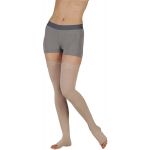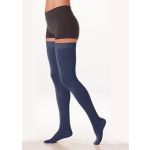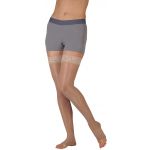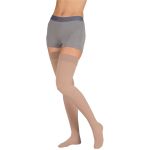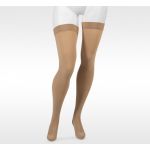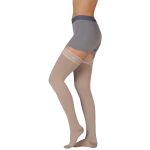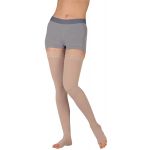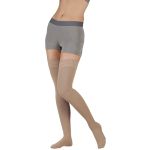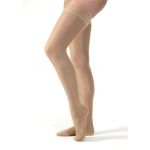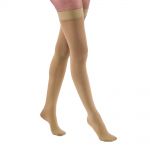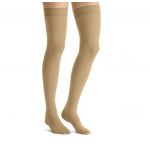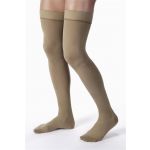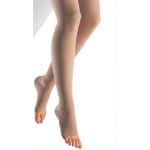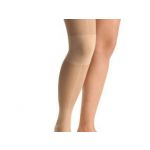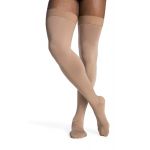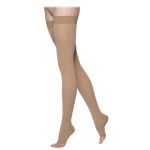Thigh High Compression Stockings
Compression Garments For Legs And Thighs
Thigh garments and compression garments for legs are a traditional means of providing compression and support to the leg, in helping to manage and treat lymphedema in legs, deep vein thrombosis (DVT) and venous insufficiencies, or for simple swelling, tired and aching feet. Thigh high compression stockings for lymphedema in legs are usually worn during the secondary or "maintenance" phase of lymphedema treatment after completion of complete decongestive therapy, or "CDT".
••••••••••••••••••••Please note: With the passage of the Lymphedema Treatment Act (LTA), effective January 1, 2024, Medicare began to pay for lymphedema products for those who have Medicare B coverage and meet certain other coverage criteria. Please visit our website page covering the details of the Lymphedema Treatment Act to obtain more information about how Medicare pays for lymphedema garments, wraps, and bandages.
Medicare Pays For Lymphedema Products
Please note: Thanks to the Lymphedema Treatment Act, which took effect on January 1, 2024, Medicare began to pay for lymphedema products for those who have Medicare B coverage and meet certain other coverage criteria. Please visit our website page covering the details of the Lymphedema Treatment Act to obtain more information about how Medicare pays for lymphedema garments, wraps, and bandages.
Compression Garments For Legs And Thighs
Compression garments for legs and lymphedema stockings for legs are made in a variety of sizes and colors and these upper thigh compression garments are especially designed to fit the various anatomical structures of the leg.
Compression garments for thighs and lymphedema stockings for legs are rated as to the amount of compression they apply, and when selecting your thigh garment it is important to choose the correct compression level that is required. Compression is measured in units referred to as millimeters of mercury or "mmHg", and should selected for treatment as follows.
While thigh high compression stockings for lymphedema in legs may be difficult to put on and take off, there are an array of compression garment donning and doffing aids which will help you to easily wear them. When you purchase compression garments for legs, be sure to protect your investment by keeping them clean by using garment care products that are specially formulated for use with your compression garments for thighs.
••••••••••••••••••••••••••••••••••••FAQs About Thigh High Compression Stockings
Compression stockings help reduce swelling in the legs and are often used to treat lymphedema, edema, chronic venous insufficiency, post-surgical swelling, and other medical conditions. Below are some of the most frequently asked questions about thigh high compression stockings (which are also sometimes referred to as leg sleeves or support stockings).
- How Do Thigh High Compression Stockings Help With Lymphedema
- Can Thigh High Compression Stockings Prevent Lymphedema
- What Are The Most Common Levels Of Compression In Thigh High Stockings
- 15-20 mmHg (mild compression)
- 20-30 mmHg (moderate compression)
- 30-40 mmHg (firm compression)
- What Does mmHg Mean In Compression Stockings
- What Does Graduated Compression Mean In Stockings
- How Do I Chose The Right Size And Type Of Compression Stocking
- Can I Exercise While Wearing Thigh High Compression Stockings
- How Tight Should My Thigh High Compression Stockings Be
- How Long Should I Wear My Thigh High Compression Stockings Each Day
- Can I Wear My Thigh High Compression Stockings While I Sleep
- What Is The Best Way To Put On And Take Off Thigh High Compression Stockings
- How Do I Care For And Clean My Thigh High Compression Stockings
- How Often Should I Replace My Thigh High Compression Stockings
- Do I Need A Prescription To Get Thigh High Compression Stockings
- Do Insurance Companies Cover Thigh High Compression Stockings
- Does Medicare Cover Compression Stockings
Thigh high compression stockings are specialized hosiery that are designed to provide gradient compression to your full leg. The stockings are tighter at the ankle and gradually decrease in pressure toward the thigh. Thigh high compression stockings help promote the flow of lymph fluid out of your leg, which can reduce the swelling and discomfort associated with lymphedema.
Lymphedema is a chronic condition, and while compression stockings cannot prevent lymphedema, they can help manage the symptoms and progression of the condition.
Thigh high compression stockings are categorized by the amount of pressure they apply to the leg, measured in millimeters of mercury (mmHg). The levels of compression in stockings can vary, but the most common ones are:
The term mmHg stands for millimeters of mercury, and it is a unit of measurement used to specify the level of compression in compression stockings. It indicates how much pressure the stockings exert on your legs to facilitate blood flow and reduce swelling. The higher the mmHg number, the higher the level of compression.
Compression stockings are designed to provide graduated compression, which means that the pressure is highest at your ankle and gradually decreases as it moves up your leg. This design on the stockings helps to promote the flow of blood back towards the heart, which can reduce swelling and prevent the accumulation of fluid in your leg tissues.
For all of our thigh high compression stockings, we have sizing charts from the manufacturer. For most thigh high compression stockings, you will take measurements at your ankle, calf, and thigh (as well as the length of your leg, from the bottom of your foot to the top of your thigh). Your healthcare provider will recommend the compression level.
Check with your healthcare provider. In general, however, wearing compression stockings while exercising can help promote circulation and reduce swelling.
Your thigh high compression stockings should be snug, but not painfully tight. The correct tightness ensures that the stockings can effectively promote blood and lymph fluid circulation, without causing discomfort or restricting blood flow. Your stocking should feel tightest at your ankle, and gradually less tight toward your thigh.
A sense of relief from swelling or aching during the day can indicate a good fit. If you experience numbness, tingling, discoloration, or pain, however, your compression stockings might be too tight or ill-fitting.
Your healthcare provider should make specific recommendations. In general, however, lymphedema compression stockings should be worn during your waking hours, especially when you are upright and moving (when gravity is most likely to cause fluid to accumulate in your legs).
Your healthcare provider should make specific recommendations. In general, however, wearing compression stockings while you are sleeping is not recommended. Compression stockings are designed to counteract the effects of gravity on blood and lymph fluid circulation while you are upright. When you lie down to sleep, the affects of gravity are greatly reduced, so compression is not usually needed.
If your healthcare provider does recommend compression at night, there are specialized nighttime wear compression garments.
Putting on thigh high compression stockings can be challenging, due to the tightness of the fabric. It can be helpful to turn the stocking inside out, up to the heel, before sliding in your foot. Then, gradually roll the compression stocking up your leg. Rubber gloves can help you grip the stocking and smooth out any wrinkles. Special donning and doffing devices can also make it easier to put on and take off compression stockings.
Follow the manufacturer’s specific instructions. In general, however, you should wash your thigh high compression stockings daily or after each use. Most stockings can be washed with mild soap and warm water, then air-dried. Avoid using fabric softeners or bleach, because these can damage the elastic fibers of the stockings. You will probably want to have at least two pairs of compression stockings, so that you can wear one while the other one is being washed and dried.
Due to wear and stretch, thigh high compression stockings lose elasticity (and effectiveness) over time and generally should be replaced every 3-6 months. A noticeable loss of compression, sagging, or damage to the fabric are signs that it is time to replace your stockings.
No. You can order all of our thigh high compression stockings without a prescription. However, we do recommend that you consult a healthcare professional to ensure that you get the recommended garment, if you are unsure as to what you need.
Some insurance plans cover compression stockings, with a prescription. Check with your insurance provider for specifics about your coverage.
Starting in January 2024, thanks to the Lymphedema Treatment Act, Medicare began covering compression products, including compression stockings. The Medicare Part B coverage is limited to: 3 daytime compression garments per affected body part (every 6 months) and 2 nighttime compression garments per affected body part (every 6 months). Click here to read more about the Lymphedema Treatment Act and how to order compression stockings.
Please note that all of the information above is for general informational purposes. Please consult your healthcare provider for specific information and personalized recommendations for your situation.
For more information about our thigh high compression stockings, please call (800) 700-1032, or e-mail info@bandagesplus.com


